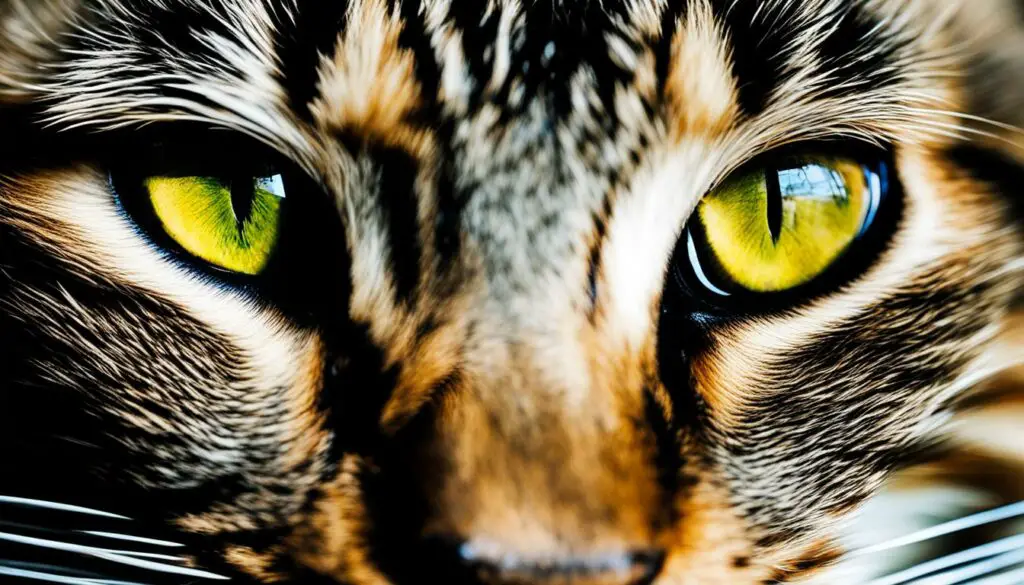As a cat owner, it is important to be aware of common eye conditions that can affect our furry friends. One such condition is a cat stye, which causes red, painful lumps to form on the eyelids. Understanding the causes, symptoms, and treatment options for cat styes is essential for maintaining your cat’s eye health and providing proper care.
In this article, I will guide you through the ins and outs of cat styes, helping you to identify the signs, explore treatment options, and learn how to prevent them in the first place. Whether you are dealing with a feline eye infection, cat eye swelling, or simply want to ensure your cat’s overall eye health, this comprehensive guide will provide you with the information you need.
Key Takeaways:
- Understanding the causes and symptoms of cat styes is essential for prompt treatment and prevention.
- Treatment for cat styes may involve medication, warm compresses, and surgical options.
- Proper veterinarian care and following their instructions are crucial for effective treatment.
- Maintaining cleanliness, monitoring interactions, and scheduling routine eye checks can help protect your cat’s eyes.
- Seeking professional veterinary care is important to ensure proper diagnosis and treatment for cat eye problems.
Common Types of Cat Eye Problems
Cats can experience a range of eye problems that can affect their overall vision and eye health. Understanding these common types of cat eye problems is important for early detection and appropriate treatment. Some of the most prevalent conditions include:
Keratoconjunctivitis Sicca (Dry Eye)
Dry eye occurs when a cat’s tear glands do not produce enough tears to keep the eyes lubricated. This can lead to discomfort, redness, and a thick, mucus-like discharge. Regular veterinary care and prescribed eye drops can help manage this condition.
Conjunctivitis (Pink Eye)
Conjunctivitis is characterized by inflammation of the conjunctiva, the thin, transparent tissue that covers the surface of the eye. It can be caused by viral or bacterial infections, as well as allergies or irritants. Symptoms include redness, swelling, discharge, and squinting. Treatment may involve medicated eye drops or ointments.
Blepharitis (Eyelid Inflammation)
Blepharitis refers to inflammation of the eyelids, which can result in redness, swelling, and crusting along the eyelid margins. It can be caused by bacterial infections, allergies, or skin conditions. Treatment includes keeping the eyelids clean and using prescribed ointments or antibiotics to reduce inflammation.
Stye (Eyelid Infection)
A stye is an infection of the eyelid sebaceous glands, resulting in a painful, red lump. It may cause discomfort, swelling, and discharge. Warm compresses and prescribed antibiotic ointments can help alleviate symptoms and promote healing.
Keratitis (Corneal Inflammation)
Keratitis is the inflammation of the cornea, the clear front surface of the eye. It can occur due to infections, injuries, or underlying health conditions. Symptoms include redness, pain, tearing, and sensitivity to light. Treatment involves prescribed medication and addressing the underlying cause.
Third Eyelid Protrusion
Third eyelid protrusion, also known as “cherry eye,” occurs when the third eyelid becomes visible due to inflammation or displacement. It can cause redness, discharge, and often requires surgical correction to prevent complications.
Watery Eyes (Epiphora)
Epiphora is excessive tearing or watery eyes, which can be caused by blocked tear ducts, allergies, or eye infections. Treatment may involve flushing the tear ducts, managing allergies, or addressing underlying infections.
Understanding the different types of cat eye problems allows cat owners to recognize symptoms early and seek prompt veterinary care. Regular eye checks, proper hygiene, and veterinary guidance are essential for maintaining optimal eye health in our feline friends.
| Eye Problem | Symptoms | Treatment |
|---|---|---|
| Keratoconjunctivitis Sicca (Dry Eye) | Redness, discharge, discomfort | Regular veterinary care, prescribed eye drops |
| Conjunctivitis (Pink Eye) | Redness, swelling, discharge, squinting | Medicated eye drops or ointments |
| Blepharitis (Eyelid Inflammation) | Redness, swelling, crusting | Keeping eyelids clean, prescribed ointments or antibiotics |
| Stye (Eyelid Infection) | Painful lump, swelling, discharge | Warm compresses, prescribed antibiotic ointments |
| Keratitis (Corneal Inflammation) | Redness, pain, tearing, sensitivity to light | Prescribed medication, addressing underlying cause |
| Third Eyelid Protrusion | Visible third eyelid, redness, discharge | Surgical correction |
| Watery Eyes (Epiphora) | Excessive tearing | Flushing tear ducts, managing allergies, addressing underlying infections |
Table: Summary of common cat eye problems, their symptoms, and recommended treatments.
Causes of Cat Eye Infections
Cat eye infections can be caused by various factors that can lead to discomfort and potential complications for our feline companions. Understanding the underlying causes of these infections is essential for effective treatment and prevention. Here are some common causes of cat eye infections:
- Feline herpes virus: This highly contagious virus is a common cause of cat eye infections and can lead to persistent conjunctivitis.
- Bacterial infections: Bacteria, such as staphylococcus or streptococcus, can cause eye infections and require proper antibiotic treatment.
- Allergies: Cats can have allergic reactions to various substances, including pollen, dust mites, or certain foods, which can result in eye irritation and infection.
- Breed/genetics: Some cat breeds may be predisposed to certain eye conditions, making them more susceptible to infections.
- Parasites: Parasites like fleas or ticks can transmit diseases that affect the eyes, leading to infections.
- Pink eye (conjunctivitis): Inflammation of the conjunctiva, often caused by viruses or bacteria, can result in eye infections in cats.
- Trauma or injury to the eye: Scratches, foreign objects, or trauma to the eye can create openings for bacteria or viruses to enter, causing infections.
- Fungus: Fungal infections, although less common, can occur in cat eyes and require specific antifungal treatment.
- Foreign objects/materials: Dust, debris, or foreign objects can irritate the eyes and lead to infections if not properly removed.
- Irritants: Chemicals, smoke, or other irritants can cause inflammation and infections in cat eyes.
- Ulcer/keratitis: Corneal ulcers or inflammation can make the eye more susceptible to infections.
- Kittens: Young kittens with underdeveloped immune systems are more vulnerable to eye infections.
Identifying the specific cause of a cat eye infection is crucial for determining the most appropriate treatment and prevention strategies. Consulting a veterinarian is essential for accurate diagnosis and guidance on how to best care for your cat’s eyes.
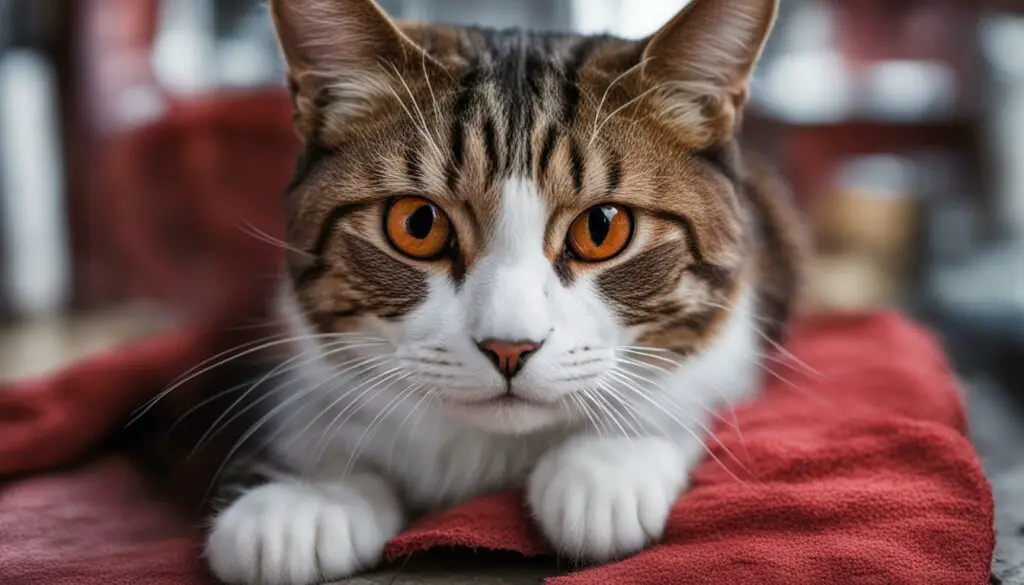
Symptoms of Feline Eye Infections: Identifying Conditions
Feline eye infections can cause a range of symptoms that can help identify the specific condition and guide proper treatment. Common symptoms of feline eye infections include:
- Pain or discomfort: Cats may exhibit signs of discomfort such as pawing at their eye or rubbing it against objects.
- Redness and swelling: The affected eye may appear red and swollen, indicating inflammation.
- Tearing of the eyes: Excessive tearing or watery eyes can be a sign of an underlying infection.
- Crusty eyelids: In some cases, discharge from the eye can cause the eyelids to become crusty.
- Sensitivity to light: Cats with eye infections may squint or shy away from bright lights.
- Inflamed or raw appearance: The eye may appear inflamed or have a raw appearance.
- Change in eye’s appearance: Eye infections can cause noticeable changes in the eye’s appearance, such as cloudiness or a change in color.
- Discharge: Cats may have discharge from the affected eye, which can range from clear or watery to thick and pus-like.
If your cat is experiencing any of these symptoms, it’s important to consult a veterinarian for a proper diagnosis and appropriate treatment.
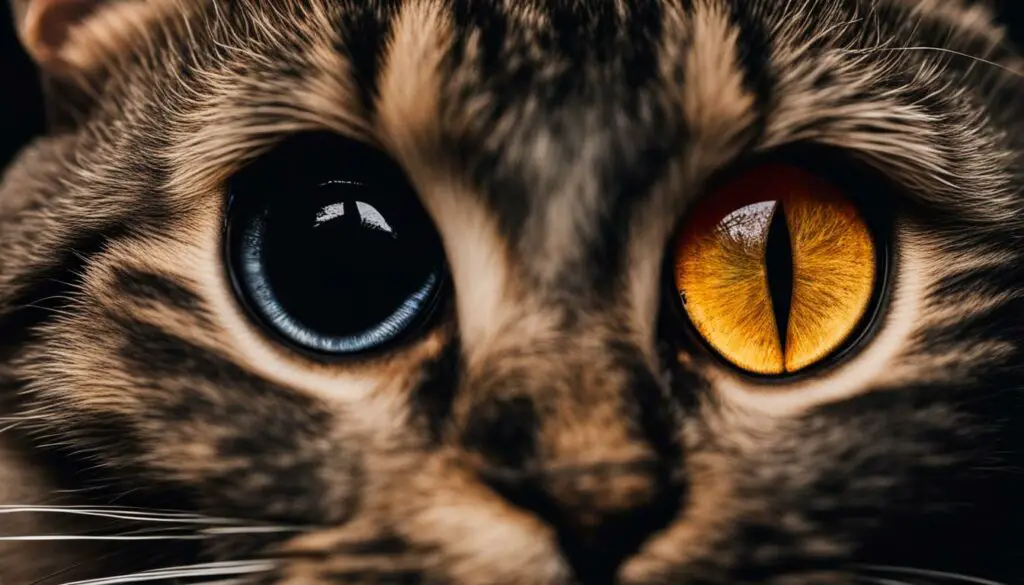
It’s essential to seek veterinary care for your cat’s eye infection and not rely on home remedies alone. Only a professional diagnosis can ensure proper treatment and care for your feline friend.
Remember, the symptoms listed above are not exclusive to feline eye infections and can vary depending on the underlying condition. It’s always best to consult with a veterinarian for an accurate diagnosis and tailored treatment plan.
What to Expect at Your Veterinarian’s Visit
When you bring your cat to the veterinarian for an eye infection, the first step is a thorough examination to determine the cause of the infection. This examination may involve various tests and procedures to gather information about your cat’s condition.
One common test is a culture or specimen collection, where a swab or sample is taken from the affected area to identify the specific bacteria or virus causing the infection. This helps the veterinarian determine the most effective treatment plan.
In some cases, a fluorescein eye stain test may be performed. This involves applying a special dye to the eye to detect any scratches or ulcers on the cornea. This test can help diagnose conditions such as corneal ulcers or keratitis.
In addition to these tests, your veterinarian may recommend blood or urine analysis to check for underlying conditions that could be contributing to the eye infection. They may also recommend FIV (feline immunodeficiency virus) testing to rule out feline AIDS, especially if your cat has a weakened immune system.
| Testing Procedure | Purpose |
|---|---|
| Culture or specimen collection | Identify the specific bacteria or virus causing the infection |
| Fluorescein eye stain test | Detect scratches or ulcers on the cornea |
| Blood/urine analysis | Check for underlying conditions contributing to the eye infection |
| FIV testing | Rule out feline AIDS |
These tests help your veterinarian gather important information about your cat’s eye infection, allowing them to provide the most appropriate and effective treatment. By following their recommendations and conducting the necessary tests, you can ensure your cat receives the care they need for a healthy recovery.
Cat Eye Infection Treatment
When it comes to treating cat eye infections, there are various options available depending on the severity of the condition and the underlying cause. The treatment may involve the use of medication such as antibiotics, anti-fungal medication, or anti-viral cream or drops. These medications are prescribed by a veterinarian and should be administered according to their instructions. It’s important to complete the full course of medication even if the symptoms improve to ensure that the infection is fully cleared.
In more serious cases or when there are underlying health conditions, surgical treatment may be necessary. This could involve procedures such as the removal of infected tissue or the correction of structural issues that contribute to the infection. Surgical treatment should always be performed by a qualified veterinarian with experience in feline eye surgery.
Some cat owners may also consider homeopathic remedies as a complementary treatment option. However, it’s important to note that these remedies should not replace veterinary care or prescribed medication. It’s best to consult with a veterinarian before using any homeopathic remedies to ensure they are safe and appropriate for your cat’s specific condition.
| Treatment Options | Description |
|---|---|
| Medication | Includes antibiotics, anti-fungal medication, or anti-viral cream or drops. Prescribed by a veterinarian and should be administered according to their instructions. |
| Surgical Treatment | In more serious cases or when there are underlying health conditions, surgical treatment may be necessary. Always performed by a qualified veterinarian with experience in feline eye surgery. |
| Homeopathic Remedies | Complementary treatment option. Should not replace veterinary care or prescribed medication. Consult with a veterinarian before using any homeopathic remedies. |
It’s important to always follow the veterinarian’s instructions when treating a cat’s eye infection. This includes administering medication correctly, following the recommended dosage, and completing the full course of treatment. Additionally, providing a clean and comfortable environment for your cat, along with regular eye care and maintenance, can also contribute to a quicker recovery.
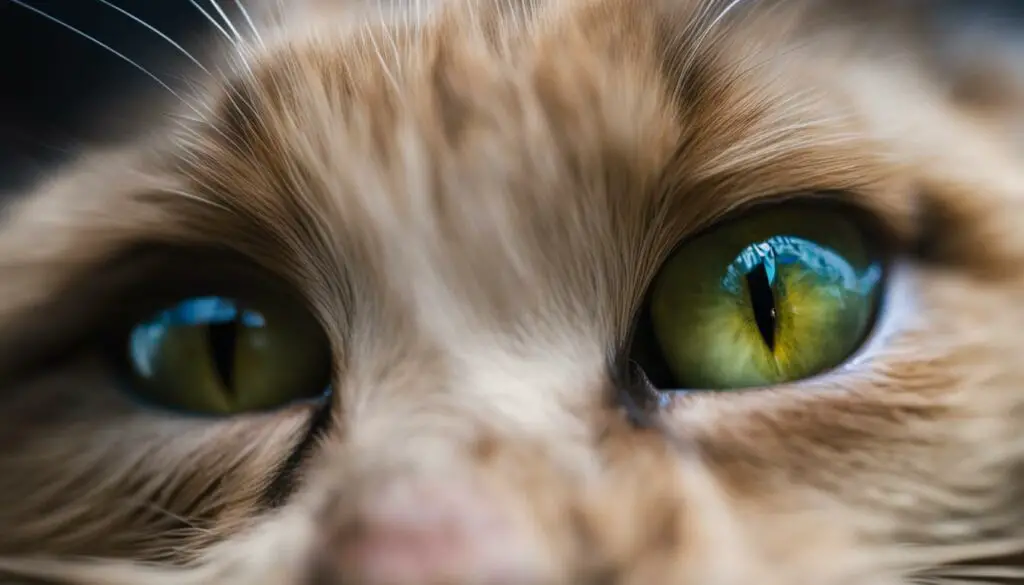
Veterinarian’s Instructions for Treating Cat Eye Infections
When it comes to treating a cat’s eye infection, it is crucial to follow the veterinarian’s instructions carefully. The veterinarian will provide specific guidelines and recommendations based on the underlying cause and severity of the infection. This includes instructions on medication, dosage, proper diet, and general guidelines for the cat’s overall care.
Medication plays a vital role in treating cat eye infections. The veterinarian will prescribe the appropriate medication, such as antibiotics, anti-fungal medication, or anti-viral cream or drops, depending on the specific infection. It is important to administer the medication as directed, following the correct dosage schedule and duration of treatment. Failure to follow the veterinarian’s instructions may result in ineffective treatment or the worsening of the infection.
Aside from medication, the veterinarian may provide recommendations for a proper diet that supports the cat’s eye health and overall well-being. A balanced and nutritious diet can help strengthen the cat’s immune system and promote healing. Additionally, the veterinarian may provide general guidelines for the cat’s care, such as avoiding exposure to irritants, maintaining cleanliness in the living environment, and monitoring for any changes in the eye’s appearance or behavior.
By listening to and following the veterinarian’s instructions, cat owners can ensure that their furry companions receive the best possible care for their eye infections. The veterinarian’s expertise and guidance are essential in effectively treating cat eye infections and promoting a speedy recovery.
| Veterinarian’s Instructions for Treating Cat Eye Infections |
|---|
| Follow medication instructions |
| Administer medication as directed |
| Provide a proper diet |
| Follow general guidelines for care |
How to Spot a Cat Stye
A cat stye is a common condition that can affect our feline friends. It is characterized by a red, painful lump that forms on the edge or inner part of the eyelid. Recognizing the signs of a cat stye is important for prompt treatment and to prevent further complications. Here are some key symptoms to look out for:
- Eye swelling: When a cat has a stye, you may notice swelling around the affected area. The eyelid may appear larger than usual and feel tender to the touch.
- Eye discharge: A cat stye can cause the eye to produce discharge, which can range from clear to yellowish in color. This discharge may be sticky or crusty and can contribute to a gritty feeling in the eye.
- Scratching at the eyes: Cats with styes may exhibit increased scratching or rubbing at their eyes. This behavior is a result of the discomfort and irritation caused by the stye.
If you notice any of these symptoms in your cat, it is important to consult your veterinarian for a proper diagnosis and treatment plan. Early intervention can help alleviate your cat’s discomfort and prevent the stye from worsening.
Remember, the information provided here is for informational purposes only and should not replace professional veterinary advice. Always consult with your veterinarian for specific guidance regarding your cat’s health.
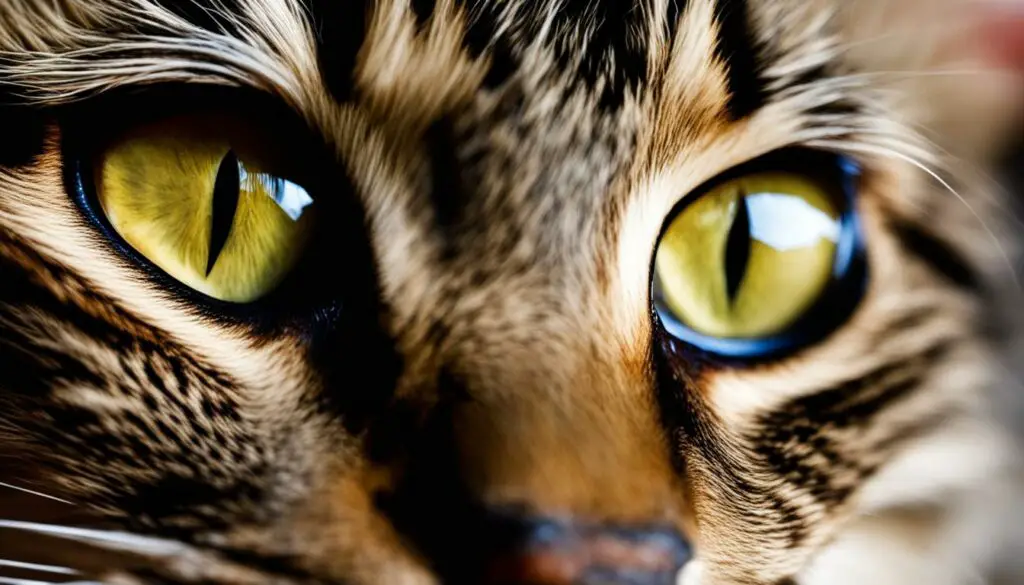
Frequently Asked Questions
Q: Can cat styes be contagious to humans?
A: It is highly unlikely for cat styes to be contagious to humans. However, it is always a good idea to practice good hygiene and avoid direct contact with your cat’s eyes.
Q: How long does it take for a cat stye to heal?
A: The healing time for a cat stye can vary depending on the severity of the infection and the effectiveness of treatment. In most cases, a stye can take a few weeks to heal completely.
Q: Can I use home remedies to treat my cat’s stye?
A: It is best to consult with your veterinarian before trying any home remedies for your cat’s stye. They can provide you with appropriate treatment options based on your cat’s individual needs.
| Stye Symptoms | Causes |
|---|---|
| Eye swelling | Bacterial infection of the eyelid sebaceous glands |
| Eye discharge | Fungal infection |
| Scratching at the eyes | Allergic reaction |
How a Cat Gets a Stye
A cat can develop a stye due to various causes, including heat and moisture, fungal infections, allergic reactions, trauma, and diabetes. Understanding these factors can help prevent styes and promote overall cat eye health.
Heat and Moisture
Cats are prone to styes when their eyelids become warm and moist, creating an environment conducive to the growth of bacteria. This can happen due to excessive tearing, particularly in breeds with prominent eyes or facial folds. Keeping the area clean and dry can help minimize the risk of styes.
Fungal Infections
Fungal infections, such as those caused by dermatophytes or yeasts, can also lead to styes in cats. These infections are often related to poor hygiene or exposure to contaminated environments. Regular grooming and cleaning of bedding and living areas can help prevent fungal infections and subsequent stye formation.
Allergic Reactions
Cats may develop styes as a result of allergic reactions to certain substances. Common allergens include pollen, dust mites, certain foods, and even certain medications. Identifying and minimizing exposure to these allergens can help reduce the likelihood of styes.
Trauma
Injuries to the eye area, such as scratches or bites from other animals, can cause styes to develop. It’s important to closely monitor cats during interactions with other pets and take immediate action if any signs of trauma or injury occur.
Diabetes
Diabetic cats are more prone to developing styes due to their compromised immune system and impaired wound healing. Controlling blood sugar levels through a proper diet and regular monitoring can help reduce the risk of styes in diabetic cats.
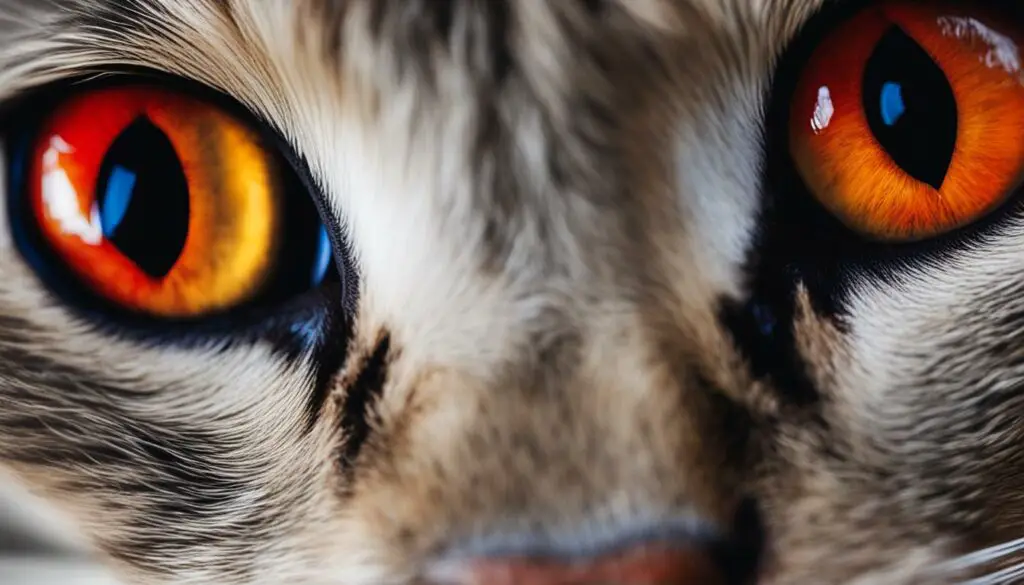
| Cat Stye Causes | Description |
|---|---|
| Heat and Moisture | Excessive tearing and warmth in the eye area |
| Fungal Infections | Contamination from dermatophytes or yeasts |
| Allergic Reactions | Sensitivity to certain substances or allergens |
| Trauma | Injuries to the eye area from scratches or bites |
| Diabetes | Compromised immune system and impaired wound healing |
What Happens if a Stye Remains Untreated?
If a cat stye is left untreated, it can lead to serious complications, including an eye infection that can cause vision loss or even blindness. Styes are caused by an infection of the eyelid sebaceous glands, and when left untreated, the infection can spread and worsen.
An untreated stye can result in the infection spreading to nearby tissues in the eye and causing inflammation. This can lead to further discomfort and pain for the cat, as well as potential damage to the eye itself. The longer a stye goes untreated, the greater the risk of complications.
To prevent these risks, it is important to seek veterinary care as soon as you notice a stye in your cat’s eye. Early treatment can help prevent the infection from spreading and minimize the potential for long-term damage. Your veterinarian will be able to provide a proper diagnosis and recommend the appropriate treatment plan for your cat.
Remember, your cat’s eye health is important, and seeking timely veterinary care is crucial to ensure the best possible outcome. Don’t ignore a stye or any other eye problem in your cat, as early intervention can make a significant difference in their overall eye health and well-being.
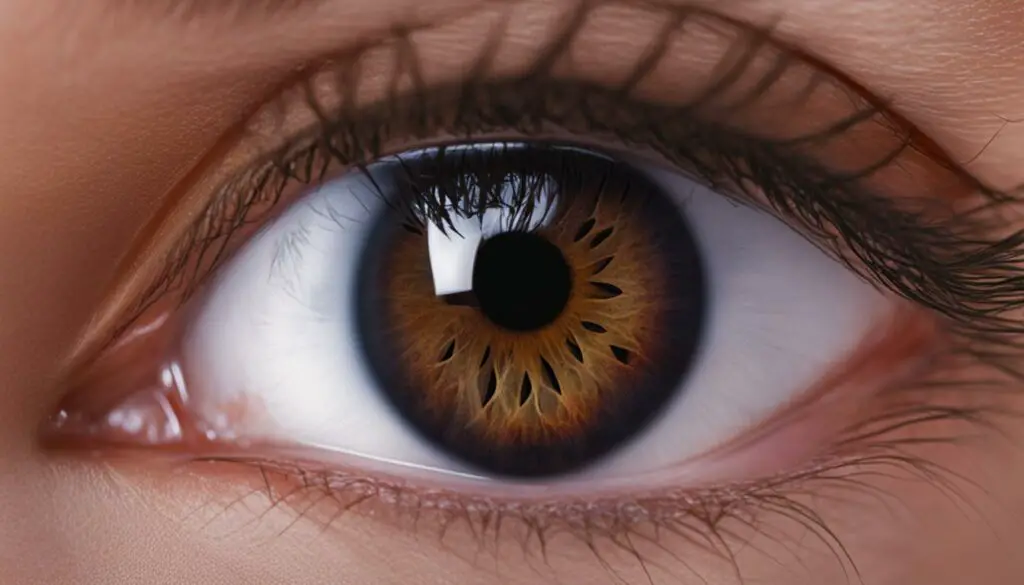
Treating a Cat Stye: Effective Methods and Remedies
When it comes to treating a cat stye, there are several effective methods and remedies that can help alleviate discomfort and promote healing. It’s important to keep the eyes clean to prevent further infection and irritation. Use a soft, damp cloth or cotton ball to gently wipe away any discharge or crust that may have accumulated. Avoid rubbing the eyes vigorously, as this can worsen the stye and cause additional pain.
Applying warm compresses to the affected eye can also provide relief. Soak a clean cloth in warm water and gently place it over the eye for a few minutes. The warm compress helps to reduce inflammation and promote drainage of the stye. Be sure to use a separate, clean cloth for each eye to prevent cross-contamination.
In some cases, a veterinarian may prescribe medication to treat the cat stye. This can include antibiotics or anti-inflammatory eye drops, depending on the severity of the infection. Follow the veterinarian’s instructions carefully and administer the medication as directed to ensure effective treatment. Additionally, some cat owners may opt for homeopathic remedies, such as herbal supplements or eye drops, to support the healing process. However, it’s important to consult with a veterinarian before using any alternative treatments to ensure their safety and efficacy.
| Treatment Method | Description |
|---|---|
| Keeping Eyes Clean | Gently wipe away discharge and crust with a soft, damp cloth to prevent further irritation. |
| Warm Compress | Place a warm, damp cloth over the affected eye to reduce inflammation and promote drainage. |
| Veterinarian-Prescribed Medication | Follow the veterinarian’s instructions and administer prescribed antibiotics or eye drops as directed. |
| Homeopathic Remedies | Consult with a veterinarian before using any alternative treatments to support healing. |
By implementing these treatment methods and remedies, you can help your cat find relief from a stye and ensure a speedy recovery. However, if the symptoms persist or worsen despite treatment, it’s crucial to seek veterinary attention for further evaluation and care. Remember, the well-being of your cat’s eyes is essential for their overall health and happiness.
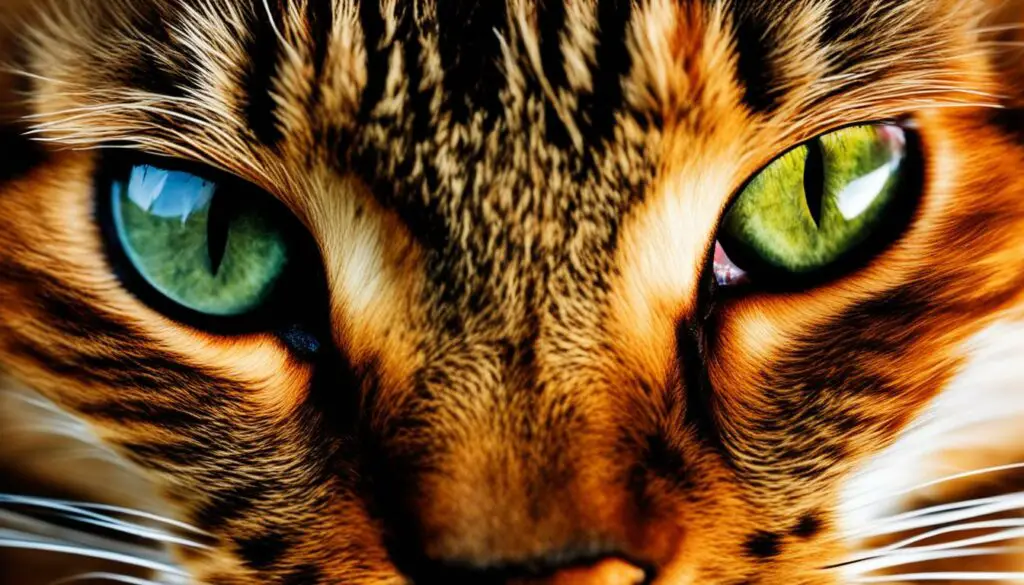
Protect Your Cat’s Eyes
Ensuring your cat’s eye health is essential for their overall well-being. Here are some proactive measures you can take to protect your cat’s eyes:
- Schedule regular eye checks: Regular visits to the veterinarian for eye examinations can help detect any potential issues or infections early on.
- Routine vet visits: In addition to eye checks, regular veterinary visits are important for your cat’s overall health and to address any concerns promptly.
- Monitor interactions with other pets: Keep an eye on your cat’s interactions with other animals to prevent any accidental injuries to the eyes, such as scratches or bites.
- Keep cats indoors: Keeping your cat indoors can reduce the risk of exposure to outdoor hazards that may cause eye injuries or infections.
- Trim nails regularly: Regular nail trims can prevent accidental scratches to your cat’s eyes during play or grooming.
- Maintain cleanliness: Keeping your cat’s living environment clean can minimize the risk of eye infections caused by dirt, dust, or other irritants.
By following these practices, you can help ensure your cat’s eyes stay healthy and avoid potential eye problems.
Table: Cat Eye Health Measures
| Measures | Description |
|---|---|
| Schedule regular eye checks | Regular visits to the veterinarian for eye examinations to detect any issues early on. |
| Routine vet visits | Regular veterinary visits for overall health and addressing any concerns. |
| Monitor interactions with other pets | Keeping an eye on interactions to prevent accidental eye injuries. |
| Keep cats indoors | Reducing the risk of outdoor hazards that may cause eye injuries or infections. |
| Trim nails regularly | Preventing accidental scratches to the eyes during play or grooming. |
| Maintain cleanliness | Keeping the living environment clean to minimize the risk of eye infections. |
Remember, the health and safety of your cat’s eyes are in your hands. Practice these measures to give your furry friend the best chance at maintaining optimal eye health.
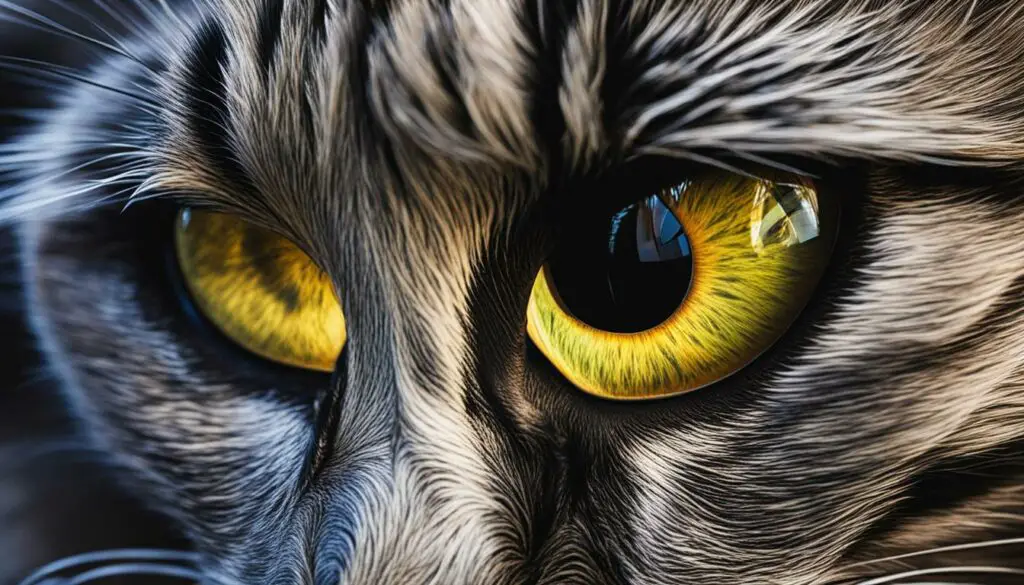
An Overview of Cat Eye Infections and Other Eye Problems
In addition to cat styes, there are various other eye problems that can affect our feline friends. Upper respiratory infections, conjunctivitis, keratitis, epiphora (excessive tears), uveitis, and third eyelid problems are some of the common issues that cats may experience. Each condition presents its own set of symptoms and treatment options.
Upper respiratory infections can cause symptoms such as sneezing, coughing, nasal discharge, and watery eyes. Conjunctivitis, also known as pink eye, is characterized by redness, swelling, and discharge from the eyes. Keratitis refers to inflammation of the cornea, resulting in eye redness, pain, and sensitivity to light. Epiphora, or excessive tears, can be caused by blocked tear ducts or other underlying issues. Uveitis is inflammation of the uvea, the middle layer of the eye, and can cause redness, pain, and changes in vision. Third eyelid problems can occur due to inflammation or protrusion of the third eyelid, resulting in eye redness and irritation.
In some cases, surgical treatment may be necessary to address certain eye problems in cats. Surgery can help correct structural abnormalities, remove tumors, or repair damage caused by trauma or injury. It is important to consult with a veterinarian to determine the most appropriate course of action for treating these conditions.
| Common Cat Eye Problems | Symptoms | Treatment Options |
|---|---|---|
| Upper respiratory infections | Sneezing, coughing, nasal discharge, watery eyes | Antibiotics, supportive care |
| Conjunctivitis | Redness, swelling, discharge from the eyes | Eye drops, antibiotics, antiviral medication |
| Keratitis | Eye redness, pain, sensitivity to light | Eye drops, anti-inflammatory medication |
| Epiphora | Excessive tearing, watery eyes | Treatment of underlying cause, tear duct flushing |
| Uveitis | Eye redness, pain, changes in vision | Anti-inflammatory medication, pain management |
| Third eyelid problems | Eye redness, irritation, protrusion of third eyelid | Topical medications, surgery if necessary |
Quote:
“The health and well-being of a cat’s eyes are vital for their overall quality of life. It is essential to monitor their eye health, seek proper diagnosis and treatment from a veterinarian, and provide them with the necessary care and attention.”
By understanding the various eye problems that cats can experience, we can better recognize symptoms and seek appropriate veterinary care. Regular eye checks, routine vet visits, and maintaining cleanliness in their living environment can help prevent and address these issues. Remember, a healthy cat is a happy cat!
The Importance of Diagnosis for Cat Eye Problems
Diagnosing cat eye problems is vital for effective treatment and proper care. Attempting to self-diagnose or relying on untested home remedies can lead to delayed treatment or ineffective solutions. It is crucial to seek professional veterinary care to accurately diagnose the underlying cause of the issue.
Proper diagnosis begins with a thorough examination conducted by a veterinarian. This may involve various tests, such as a culture or specimen analysis, fluorescein eye stain, or blood/urine analysis. These diagnostic procedures help identify the specific problem, whether it’s an infection, inflammation, or another condition.
Once a diagnosis is made, the veterinarian can recommend the appropriate treatment plan. This may include medications, such as antibiotics, anti-fungal medication, or anti-viral creams or drops. In some cases, surgical intervention may be necessary. It’s important to follow the veterinarian’s guidance and administer medications as directed to ensure the best possible outcome.
While home remedies may seem appealing, they should be avoided without professional advice. Home remedies often lack scientific evidence and may not address the underlying cause of the problem. Relying solely on home remedies can lead to further complications or delays in proper treatment. It is always best to consult with a veterinarian for expert guidance and to prioritize the health and well-being of your cat.
| Diagnosis Importance for Cat Eye Problems | Treatment | Proper Care |
|---|---|---|
| Accurate diagnosis ensures effective treatment | Medication, surgery, or other interventions | Consulting a veterinarian for expert guidance |
| Professional examination and diagnostic tests | Follow veterinarian’s treatment plan | Avoid untested home remedies |
| Identification of underlying cause | Administer medications as directed | Prioritize your cat’s health and well-being |
Treating Cat Eye Problems: When to Seek Veterinary Care
If your cat is experiencing eye problems, it’s important to know when to seek veterinary care. While some minor issues can be treated at home, more serious conditions require professional attention to prevent further complications. Avoid relying on untested home remedies and consult a veterinarian for proper diagnosis and treatment.
When you notice any abnormal signs in your cat’s eyes, such as redness, swelling, discharge, or excessive scratching, it’s time for a trip to the vet. A qualified veterinarian will be able to perform a thorough examination and determine the underlying cause of the problem. This may involve tests such as cultures, eye stains, or blood/urine analysis.
Once a diagnosis is made, your veterinarian will recommend the appropriate treatment plan. This may include medication administration, such as antibiotics, anti-fungal medication, or anti-viral creams or drops. It’s crucial to follow the veterinarian’s instructions regarding dosage and frequency.
In some cases, surgical treatment may be necessary to address more severe eye conditions. Your veterinarian will discuss the options and guide you through the process. Remember to always listen to your veterinarian and follow their recommendations to ensure the best possible outcome for your cat’s eye health.
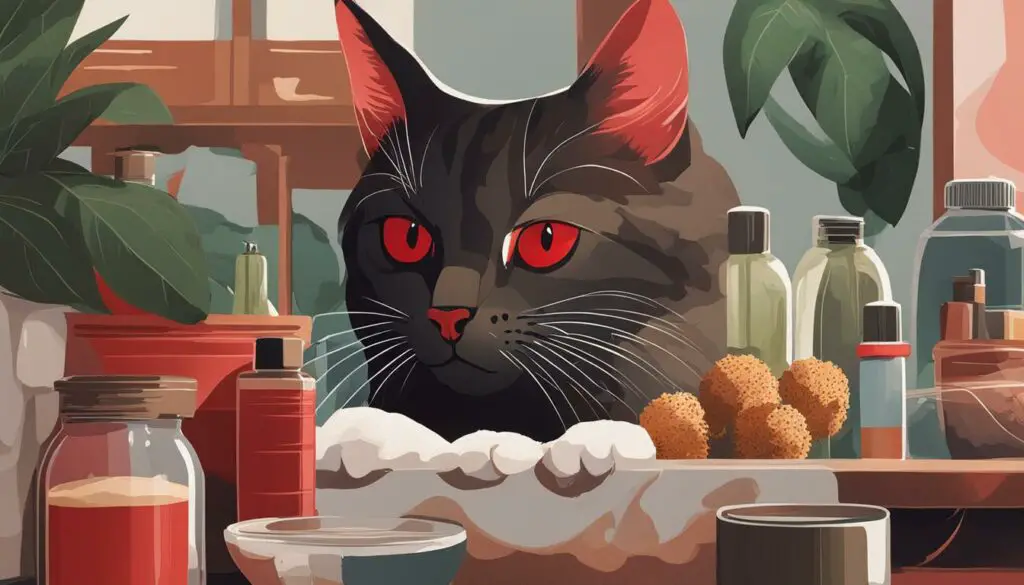
Signs that warrant veterinary care for cat eye problems:
- Redness, swelling, or discharge
- Excessive scratching or rubbing of the eyes
- Changes in the appearance of the eyes
- Abnormal sensitivity to light
- Any signs of pain or discomfort
Remember, your cat’s eyes are delicate and require proper care. Seeking veterinary care for cat eye problems ensures that your furry friend receives the necessary treatment and helps prevent potential complications. Trust your veterinarian’s expertise and follow their recommendations for the well-being of your cat’s eyes.
Conclusion
In conclusion, maintaining cat eye health is essential for the overall well-being of our feline friends. By prioritizing prevention, providing proper treatment, and seeking regular veterinary care, we can ensure that our cats enjoy optimal eye health throughout their lives.
Prevention plays a crucial role in preserving cat eye health. Regularly scheduling eye checks and routine vet visits allows for early detection of any problems and prompt intervention. It is also important to monitor interactions with other pets to minimize the risk of eye injuries. Keeping cats indoors helps protect their eyes from outdoor hazards, such as foreign objects or irritants. Additionally, maintaining a clean living environment and regularly trimming their nails can further prevent eye infections and injuries.
When it comes to treating cat eye problems, it is vital to prioritize proper veterinary care. While it may be tempting to try home remedies, these should be avoided without a professional diagnosis. Only a veterinarian can accurately diagnose the underlying cause of the problem and provide appropriate treatment. Following veterinarian recommendations, especially when administering medication to your cat, is crucial for successful treatment and optimal outcomes.
By prioritizing cat eye health, practicing prevention, and seeking proper veterinary care, we can ensure that our feline companions enjoy clear vision and optimal eye health. Remember, your cat’s eyes are precious, and their well-being deserves the best care possible.
FAQ
What is a cat stye?
A cat stye is a red, painful lump that forms on the eyelids of cats.
What are the causes of cat styes?
Cat styes can be caused by factors such as heat and moisture, fungal infections, allergic reactions, trauma, and diabetes.
What are the symptoms of a cat stye?
Symptoms of a cat stye may include eye swelling, eye discharge, scratching at the eyes, and discomfort.
What happens if a cat stye is left untreated?
If left untreated, a cat stye can worsen and potentially lead to an eye infection, vision loss, or blindness in the affected eye.
How is a cat stye treated?
Treatment for a cat stye may involve keeping the eyes clean, applying warm compresses, using veterinarian-prescribed medication, and considering homeopathic remedies.
How can I protect my cat’s eyes?
To protect your cat’s eyes, schedule regular eye checks, routine vet visits, monitor interactions with other pets, keep cats indoors, trim nails regularly, and maintain cleanliness in their living environment.
What are some common types of cat eye problems?
Common types of cat eye problems include keratoconjunctivitis sicca, conjunctivitis, blepharitis, stye, keratitis, third eyelid protrusion, and watery eyes.
What are the causes of cat eye infections?
Cat eye infections can be caused by factors such as feline herpes virus, bacterial infections, allergies, breed/genetics, parasites, pink eye, trauma or injury to the eye, fungus, foreign objects/materials, irritants, ulcer/keratitis, and kittens with weak immune systems.
How are feline eye infections diagnosed?
A veterinarian will conduct a thorough examination, which may include taking a culture or specimen, performing a fluorescein eye stain test, conducting blood/urine analysis, and possibly recommending FIV testing to rule out feline AIDS.
What are the treatment options for cat eye infections?
Treatment for cat eye infections may involve the use of medication such as antibiotics, anti-fungal medication, or anti-viral cream or drops. In more serious cases or underlying health conditions, surgical treatment may be necessary.
Are home remedies effective for treating cat eye problems?
Home remedies should be avoided without a professional diagnosis, as they may not address the underlying cause of the problem. It is important to seek proper veterinary care and treatment for cat eye problems.
Source Links
- https://canna-pet.com/articles/cat-eye-infections-recognizing-treating-cats-symptoms/
- https://www.litter-robot.com/blog/cat-eye-infections/
- https://www.dailypaws.com/cats-kittens/health-care/cat-conditions/cat-eye-infection

